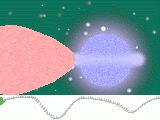Beta Lyrae
| Observation data Epoch J2000.0 Equinox J2000.0 | |
|---|---|
| Constellation | Lyra |
| Right ascension | 18h 50m 04.8s |
| Declination | +33° 21′ 46″ |
| Apparent magnitude (V) | 3.52 (3.4–4.3) |
| Characteristics | |
| Spectral type | B7Ve/A8Vp |
| U−B color index | −0.56 |
| B−V color index | 0.00 |
| Variable type | β Lyr |
| Astrometry | |
| Radial velocity (Rv) | −19.2 km/s |
| Proper motion (μ) | RA: 1.10 mas/yr Dec.: −4.46 mas/yr |
| Parallax (π) | 3.70 ± 0.52 mas |
| Distance | approx. 900 ly (approx. 270 pc) |
| Absolute magnitude (MV) | −3.91 |
| Details | |
| Mass | 2/12 M☉ |
| Radius | 19/15 R☉ |
| Luminosity | 2,500/230 L☉ |
| Temperature | 13,000/8,000 K |
| Metallicity | ? |
| Rotation | ? |
| Age | ? years |
| Other designations | |
Beta Lyrae (β Lyr / β Lyrae) is a binary star system approximately 882 light-years away in the constellation Lyra. Beta Lyrae is traditionally named Sheliak which is Arabic for "tortoise" or "harp."

Beta Lyrae is an eclipsing contact binary star system made up of a blue-white dwarf (B7V) star and a white main sequence (A8V) star. The two stars are close enough that material from the photosphere of each is pulled towards the other, drawing the stars into an ellipsoid shape. Beta Lyrae is the prototype for this class of eclipsing binaries, whose components are so close together that they deform by their mutual gravitation.
Beta Lyrae changes its apparent magnitude from +3.4 to +4.6 over a period of 12.9075 days. The two components of the main star are so close together that they cannot be resolved with optical telescopes, forming a spectroscopic binary.
The system also has a third star, at an angular distance of 45.7", which is of spectral type B7V and has an apparent magnitude of +7.2 and can easily be seen with binoculars. It is about 80 times as luminous as the Sun and is also a spectroscopic binary with a period of 4.34 days. There is also another star that appears to be in the Beta lyrae system, F, magnitude 9.9v separation 86" and luminosity 7 times that of the Sun.
See also
External links
- Prof. Kaler, Jim. "Sheliak".
- "Watching Beta Lyrae Evolve".
- "Sheliak". Alcyone ephemeris.
{{cite web}}: Italic or bold markup not allowed in:|work=(help)
